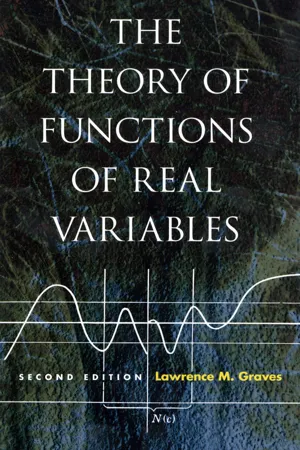Mathematics
General Solution of Differential Equation
The general solution of a differential equation is a family of solutions that includes all possible specific solutions to the equation. It typically contains arbitrary constants that can take on different values, allowing for a wide range of specific solutions. Finding the general solution is important in solving differential equations and understanding the behavior of the system they model.
Written by Perlego with AI-assistance
Related key terms
7 Key excerpts on "General Solution of Differential Equation"
- eBook - ePub
An Elementary Treatise on Fourier's Series
and Spherical, Cylindrical, and Ellipsoidal Harmonics, with Applications to Problems in Mathematical
- William Elwood Byerly(Author)
- 2014(Publication Date)
- Dover Publications(Publisher)
arbitrary functions.A particular solution of a differential equation is a relation between the primitive variables which is consistent with the given differential equation, but which is less general than the general solution, although included in it.Theoretically, every particular solution can be obtained from the general solution by substituting in the general solution particular values for the arbitrary constants or particular functions for the arbitrary functions; but in practice it is often easy to obtain particular solutions directly from the differential equation when it would be difficult or impossible to obtain the general solution.3.If a problem requiring for its solution the solving of a differential equation is determinate, there must always be given in addition to the differential equation enough outside conditions for the determination of all the arbitrary constants or arbitrary functions that enter into the general solution of the equation; and in dealing with such a problem, if the differential equation can be readily solved the natural method of procedure is to obtain its general solution, and then to determine the constants or functions by the aid of the given conditions.It often happens, however, that the general solution of the differential equation in question cannot be obtained, and then, since the problem if determinate will be solved if by any means a solution of the equation can be found which will also satisfy the given outside conditions, it is worth while to try to get particular solutions and so to combine them as to form a result which shall satisfy the given conditions without ceasing to satisfy the differential equation.4.A differential equation is linear when it would be of the first degree if the dependent variable and all its derivatives were regarded as algebraic unknown quantities. If it is linear and contains no term which does not involve the dependent variable or one of its derivatives, it is said to be linear and homogeneous - eBook - ePub
- Clayton R. Paul(Author)
- 2011(Publication Date)
- Wiley-IEEE Press(Publisher)
to use mathematical skills to determine what the equations governing the system are telling us about how the system behaves.4.2 WHERE THEY ARISE: THE MEANING OF A SOLUTIONIn Chapter 1 we showed examples of where differential equations arise in electrical and mechanical engineering systems. Ordinary differential equations can be found routinely in all of engineering.How do we know that a particular formula for x(t) is a solution to the differential equation? The simple method is to substitute it into the differential equation, perform the required differentiations, and see if satisfies the equation [i.e., both sides of (4.1) are the same]. However, unlike algebraic equations, differential equations have an infinite number of possible solutions. So we need some additional information to pin down which of these is the actual solution for the problem we are investigating. This additional information comprises what are called the initial conditions for the specific problem being investigated. For example, consider the first-order equation in (4.1a). For the specific problem that this differential equation describes, we would need to specify an additional initial condition for the value of x (t) at some starting time, say t = 0, which we denote as x (0). So the complete specification of the problem would be to specify (a) the differential equation and (b) the initial condition as(4.1a)Once we have obtained a solution x(t) that satisfies this differential equation and the initial condition, we can say that the solution x(t) is valid for all t ≥ 0. Similarly, the second-order equation in (4.1b) requires two initial conditions: x(0) and its derivative att = 0,dx(t)/dt\t=0 ≡ - Christopher Jekeli(Author)
- 2023(Publication Date)
- De Gruyter(Publisher)
t . Certain classes of differential equations have solutions that can be found analytically using various rules or formulas and others have no analytic solution. In the general case of arbitrary equations, if an analytic solution exists, it must be guessed and checked by back-substitution (that is, a putative solution certainly must satisfy the differential equation). With today’s modern computational capabilities, numerical methods are more common than in the past and often the only viable course to follow.Since solving a differential equation, in essence, involves an integration, it is important to note that the solution is incomplete without a constant of integration. The solution to a differential equation of order m requires m integrations, implying that m constants must be specified. These constants are also known as initial conditions, and we may think of them as indicating the values of the function and itsm − 1derivatives at some (usually) initial time,t 0. Thus (2.1) should include the following statement,(2.2)y jt 0=μ j, j = 0 , … , m − 1 ,where theμ jare constants with given values.Differential equations pervade the study of inertial navigation systems, from the dynamics of the sensors to the determination of a navigation solution and the analysis of the associated errors. In particular, the differential equations associated with coordinate transformations that we already encountered in Section 1.4 play an essential role in the navigation solution. However, it is clearly not the intent here to fully develop the theory of differential equations. Only results useful to our exposition of INS and its applications will be derived. This includes a general treatment of linear ordinary differential equations with discussion of analytic solutions and one method of numerical solution.- eBook - ePub
Essentials of Physics Series
An Introduction
- Derek Raine(Author)
- 2018(Publication Date)
- Mercury Learning and Information(Publisher)
6DIFFERENTIAL EQUATIONS 1
Differential equations are fundamental to physical science. The behavior of any system continuously evolving in time (the motion of a body subject to a force, a chemical reaction, ...) is governed by one or more differential equations. So is the behavior of continuous systems in space. Solving the equations means finding out how the body moves given the forces acting, how the reaction proceeds given the reagents etc. Only the simplest of equations can be solved exactly. But these are important in developing a physical intuition for the sort of behavior to expect. (Conversely a good physical insight will provide a basis for the mathematical solution.) They are also used later in the derivation of approximations to the solutions of more complex equations. You need to develop a good understanding of the equations in this chapter.6.1.WHAT ARE DIFFERENTIAL EQUATIONS?
A differential equation is an equation for an unknown function, y (t ) say, of an independent variable (in this case t ) that involves one or more derivatives of y with respect to t .Example 6.1 Here are some examples of differential equations, from different fields.A simple model for population growth (with λ > 0), or radioactive decay (with λ < 0)Simple harmonic motion, ω a constantGovernor of steam turbine Motion of a planet in general relativityEconomics growth model, A, B constantsGeophysics, f (x ) a given function of xThe order of a differential equation is the number of the highest derivative appearing in it.Example 6.2 What are the orders of equations (6.1) and (6.3)?Equation (6.1) is first order because it contains only first derivatives (i.e. dy/dt ).Equation (6.3) is third order because the number of the highest derivative is 3 (i.e. d 3 y/dt 3 ).Exercise 6.1 What are the orders of the differential equations(6.2) and (6.4) to (6.6)?It might be helpful to clarify the notation that is used for differential equations. If a function y depends on time t we often write ẏ instead of dy/dt, ÿ for d 2 y/dt 2 etc. If the independent variable is not time but position, x , we may use “prime” symbols like y′ , y″ , . . . y n for dy/dx, d 2 y/dx 2 , . . . , d n y/dx n - eBook - ePub
- Dan Stanescu, Long Lee(Authors)
- 2022(Publication Date)
- Chapman and Hall/CRC(Publisher)
initial value problem. Furthermore, we assume that the initial value problems presented below do have a unique solution. Although a thorough mathematical analysis of the existence and uniqueness of solutions of differential equations is beyond an elementary treatment of the subject, the reader is again encouraged to consult [1].10.1.1 Classical mechanics
Newton's second law of motion leads quite naturally to such first-order differential equations. Consider, for the simplest possible example, the motion of a compact body of mass m, in free fall under the effect of gravity. The law of motion states that the force acting on the body is, whereF →= ma →= mg →is the acceleration exhibited by the body,a →= dv →/ d tits velocity andv →( t )mis the force due to the object being in the gravity field of the Earth. Upon projection on the vertical direction (with positive sign usually chosen towards the surface of the Earth) the vectorial equation of motion becomes a differential equation for the velocity magnitudeg →v ( t ),d v / d t = g. This can be solved immediately, in what amounts to a simple calculus exercise, to yieldv ( t ) =, with v0 the initial velocity at timev 0+ g tt = 0and g - eBook - ePub
The Theory of Functions of Real Variables
Second Edition
- Lawrence M Graves(Author)
- 2012(Publication Date)
- Dover Publications(Publisher)
CHAPTER IX ORDINARY DIFFERENTIAL EQUATIONS1. Conditions Ensuring the Existence of Solutions. —In the following we shall let x denote the single real independent variable, and let y denote the dependent variables, of which there may be any finite number. Derivatives with respect to x will be denoted by accents. Thus a system of differential equations involving only first derivatives may be written in the formAn equation or a system of equations involving derivatives of higher orders may always be reduced to a system of the form (1:1) by the introduction of new dependent variables. For example, consider the equationIf we set y1 = y, y2 = y′, equation (1:2) is equivalent to the systemWe shall begin by considering systems of the formin which the derivatives are expressed explicitly as functions of x and y. Here it is understood that the number of equations is the same as the number of dependent variables y which are to be determined as functions of x. If there is only one equation and one variable y, the equation (1:4) may be pictured as attaching to each point in a region of the xy-plane a line whose slope is f(x, y). The problem of solving the differential equation is that of finding a curve having as its tangent at each point the line attached to that point. The extension of this geometrical interpretation to more dimensions is immediate.By a solution of (1:4) we shall mean a differentiable function y(x) defined on an (open or closed) interval (a, b) and such that y′(x) = f(x, y(x)) identically on (a, b). The set of all points (x, y(x)) with x on (a, b) is called thegraphof the solution. There will in general be infinitely many solutions. If we adjoin to the differential equation (1:4) initial conditions of the form y(ξ) = η, then the solution on an interval (a, b) containing ξ is uniquely determined, provided the function f has suitable properties. The requirement that the solution shall satisfy the initial condition y(ξ) = η is expressed geometrically by saying that the graph of the solution shall pass through the point (ξ, η). We shall be interested in studying the properties of the solution as a function y(x, ξ, η) of x and these initial values. The variables ξ and η constitute a special choice of the constants of integration, convenient for theoretical purposes. In a sufficiently restricted domain the complete family of solutions is obtained with the value of ξ fixed. In the first theorem to be proved the domain of the function f - Vladimir Dobrushkin(Author)
- 2017(Publication Date)
- Chapman and Hall/CRC(Publisher)
“Equivalent” means that each solution to the higher order equation uniquely corresponds to a solution to the first order system and vice versa. Recall that | a, b | denotes any interval (open, closed, or semi-closed) with endpoints a, b A first order system of ordinary differential equations has the general form (6.5.1) d u 1 d t = f 1 (t, u 1, …, u n), ⋯, d u n d t = f 1 (t, u 1, …, u n). The unknowns u 1 (t), …, u (t) are scalar functions of a real variable t, which usually represents time. The righthand side functions f 1 (t, u 1, …, u n), …, f n (t, u 1, …, u n) are given functions of n + 1 variables. It is customary to denote the derivative with respect to the time variable by a dot, that is, d u d t = u ˙. By introducing column vectors f = f 1, f 2, …, f n T, we rewrite Eq. (6.5.1 in a vector form: (6.5.2) du d t = f (t, u) or u ˙ = f (t, u). Definition 6.10: A solution to a system of differential equations (6.5.1 on an interval | a, b | is a vector function u (t) with n components that are continuously differentiable on the interval | a, b |; moreover, u (t) satisfies the given vector equation on its interval of definition. Each solution u (t) serves to parameterize a curve in n -dimensional space, also known as a trajectory, streamline, or orbit of the system. When we seek a particular solution that starts at the specified point, we impose the initial conditions (6.5.3) u 1 (t 0) = u 10, u 2 (t 0) = u 20, …, u n (t 0) = u n 0 or u(t 0) = u 0 Here t 0 is a prescribed initial time, while the column vector u 0 = u 10, u 20, …, u n 0 T fixes the initial. position of the desired solution. In favorable situations, to be formulated shortly, the initial conditions serve to uniquely specify a solution to the differential system of equations—at least for nearby times
Index pages curate the most relevant extracts from our library of academic textbooks. They’ve been created using an in-house natural language model (NLM), each adding context and meaning to key research topics.






